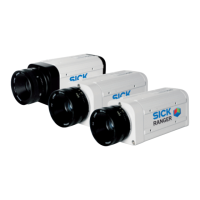Reference Manual Chapter 5
Ranger E/D
©SICK AG • Advanced Industrial Sensors • www.sick.com • All rights reserved 57
Configuring Ranger E and D
handled by the calibration functions of iCon. Note that the y-axis may be directed as in
either of the two cases in the image depending on if the camera is facing the approaching
object or watching it from the rear.
Figure 5.20 – Real-World object in laser plane and its appearance on the sensor
5.10.1 Calibrated Data
Calibrated data is a set of (x, r) points (in real-world coordinates). During the configuration
of the calibration, a direct relation is established between each sensor position (u, v) and
the corresponding real-world coordinate. These relations are stored in a calibration lookup
table (LUT). When applying the calibration filter to a range profile, each valid (u, v) point in
the profile is translated into a calibrated (x, r) point in the real world. This representation is
suitable if you need to find e.g. the distance between two points in the real world or meas-
ure the height of a certain object. The image below shows an example profile as seen by
the sensor (on the left) and the corresponding calibrated points in the real world coordi-
nate system.
Figure 5.21 – Sensor image and corresponding calibrated points
5.10.2 Rectified Images
Rectification of data means that a new profile is created by re-sampling the calibrated data
onto a regular grid. The rectification in iCon is performed along the X-axis only. The new
x
y
r
y
v
u
Sensor Image
Real-World
Object
z
Sensor Image
x
r
Calibrated (x, r) Points
u
v

